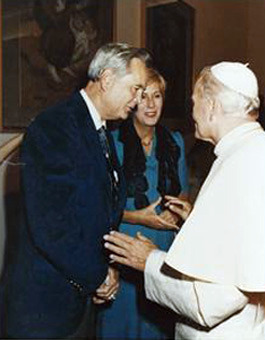Farewell to a Valiant Pro-Life Woman
Anne Higgins (1939-2010)

A great pro-life heroine died in Washington, D.C., on Aug. 12. Anne V. Higgins — “AVH” as she was known to the correspondence staffs of three U.S. presidents — gave her all for unborn babies’ right to life, despite her 30-year battle with various cancers. Higgins’ career is a model for any Catholic who enters public service.
Anne E. Volz was born in New York City to William and Elizabeth Volz. Her father, a firefighter, worked two jobs in post-war America to raise his family. She attended Catholic grade school at Holy Rosary and St. Helena High School in the Bronx.
At her funeral Mass at St. Stephen Martyr in the Foggy Bottom neighborhood of Washington on Aug. 18, Higgins’ surviving brother, Bob, described how she wept for hours at the assassination of John F. Kennedy in 1963. In his eulogy, Pat Buchanan said his long friendship with her began when she was the receptionist in the Manhattan law office of Richard Nixon; the two were working on Nixon’s second presidential campaign. He summarized her core traits as loyalty, courage and compassion.
When Nixon won in 1968, he brought Higgins with him to the White House as his director of correspondence. That position, a longtime function of the State Department, blossomed under her leadership into a primary means of personal communication between the president and the American people. Higgins’ ability to inspire and administer a team of mail analysts, writers, production staff, quality-control personnel and volunteers transformed the correspondence operation into an invaluable presidential asset.
Higgins served in the same position for President Gerald Ford and then returned to full-time work in her first passion: She helped lead the Ad Hoc Committee in Defense of Life, a project of National Review publisher J.P. McFadden. This Washington-based lobby was allied with two national publications, “Lifeletter” and Human Life Review, political and intellectual mainstays of the pro-life movement.
Higgins played a key role in the election of Ronald Reagan by helping to unite the pro-life movement behind him during a crucial phase of the 1980 primary season. She was a natural choice to become President Reagan’s correspondence director. Reagan was a prolific letter writer, and she was responsible for ensuring he received a weekly sample of letters from the public. Many of those letters made their way into the president’s speeches. Letters encouraging the president in his pro-life stance regularly made it into the sample.
The White House correspondence unit also was a hub of hospitality for visitors to Washington. Actors Ernest Borgnine and the late Patricia Neal, who were friends of the Reagans; Cardinal John Foley, who later became the “voice of the Vatican”; Msgr. William Lori, later to become the bishop of Bridgeport, Conn.; and pro-life guests seeking a warm respite during the March for Life were just some of the many who made their way to Higgins’ offices in the Old Executive Office Building.
This hospitality, a recognition that the White House belongs to the people, was allied with limitless compassion. Anne Higgins exemplified Jesus’ mandate in Matthew 25 to care for “the least of these.” She helped citizens sort out their problems with government programs and work through legal immigration woes, and even made her offices a home for stray animals the Secret Service rescued on the White House grounds. Every Christmas Eve, she and her husband, George, brought gift bags full of necessities and treats “from Santa” to D.C.’s street people. And at home, this special assistant to the president quietly did housework and errands for her elderly neighbors, including William Carrigan, the man who introduced St. Padre Pio to America.
Loving unborn babies and mothers in need, Higgins was active in the pregnancy-care movement. She encouraged President Reagan’s vocal support for the cause and engineered the founding of one of D.C.’s first centers in the basement of St. Stephen’s. The center now has office space and a home for unwed mothers in northwest D.C.
Her zest for life was legendary. Her annual St. Patrick’s Day Parade in the White House featured a (loud!) bagpiper leading the way and many of her staff wearing green. At all of her office parties, she made sure the White House’s janitors and cleaning ladies could join in the fun.
On holy days of obligation, Higgins always checked with her Catholic staffers to make sure they could get to Mass. Such kindness was just one of the memories that evoked many tears but also laughter and good cheer on the day of her funeral. Fittingly, she was laid to rest in Mount Olivet Cemetery in northeast Washington. There also lie the remains of her husband and those of an unknown, unborn baby she helped to honor with a ceremonial marker in 1978.
Anne Higgins was one of a kind. Surely the God she served with such faith and goodness is welcoming her with the hospitality she constantly showed to others, a hospitality warmed now by the presence of the many babies she strived to save and those she could not, a hospitality that “no eye has seen, nor ear has heard.”
The authors served under Anne Higgins in the Office of Presidential Correspondence in the Reagan administration. Dan Engler is the Register’s TV critic.
Contributions in her memory may be made to Human Life Foundation, 353 Lexington Ave., Room 802, New York, NY 10016.













